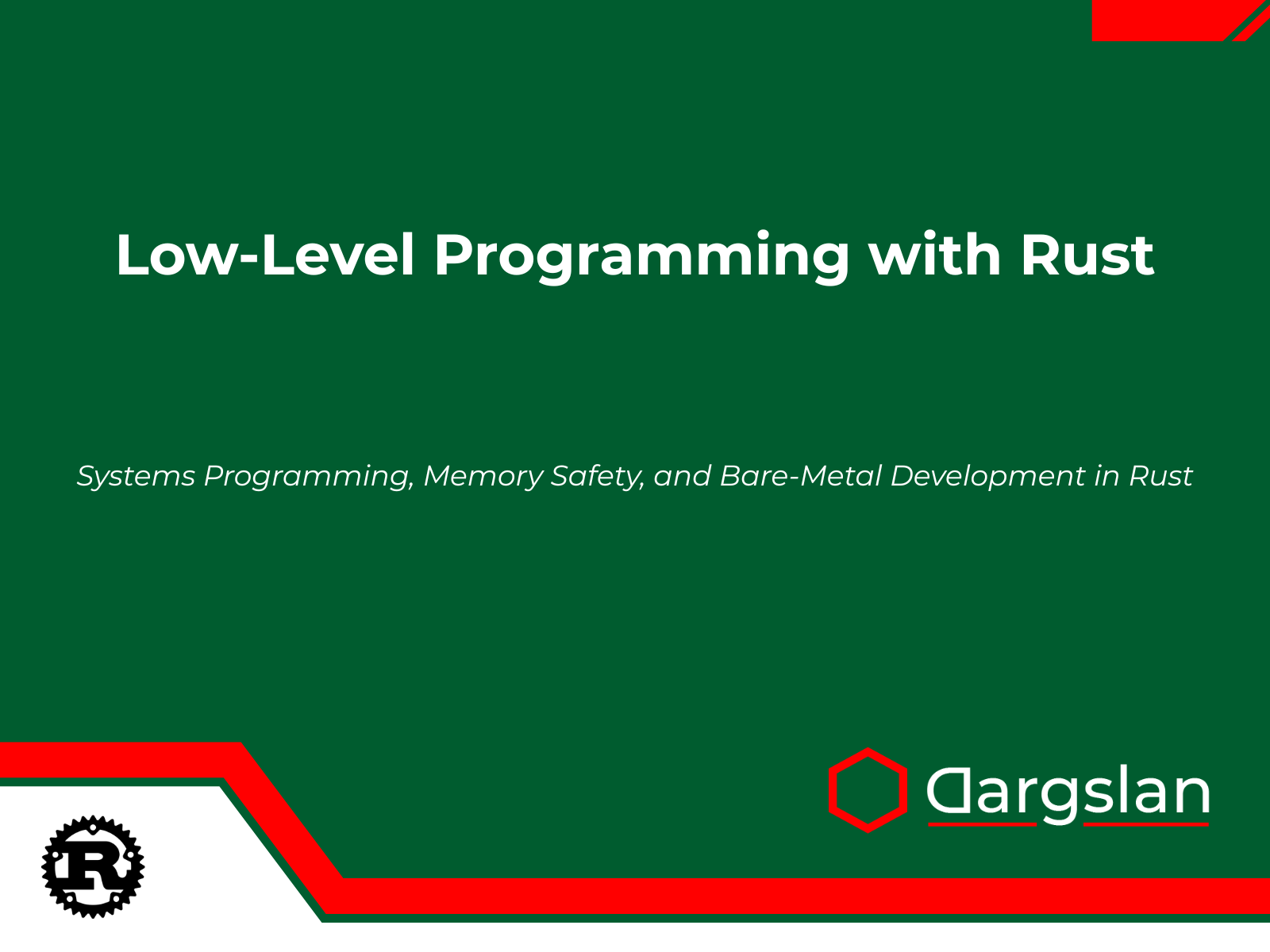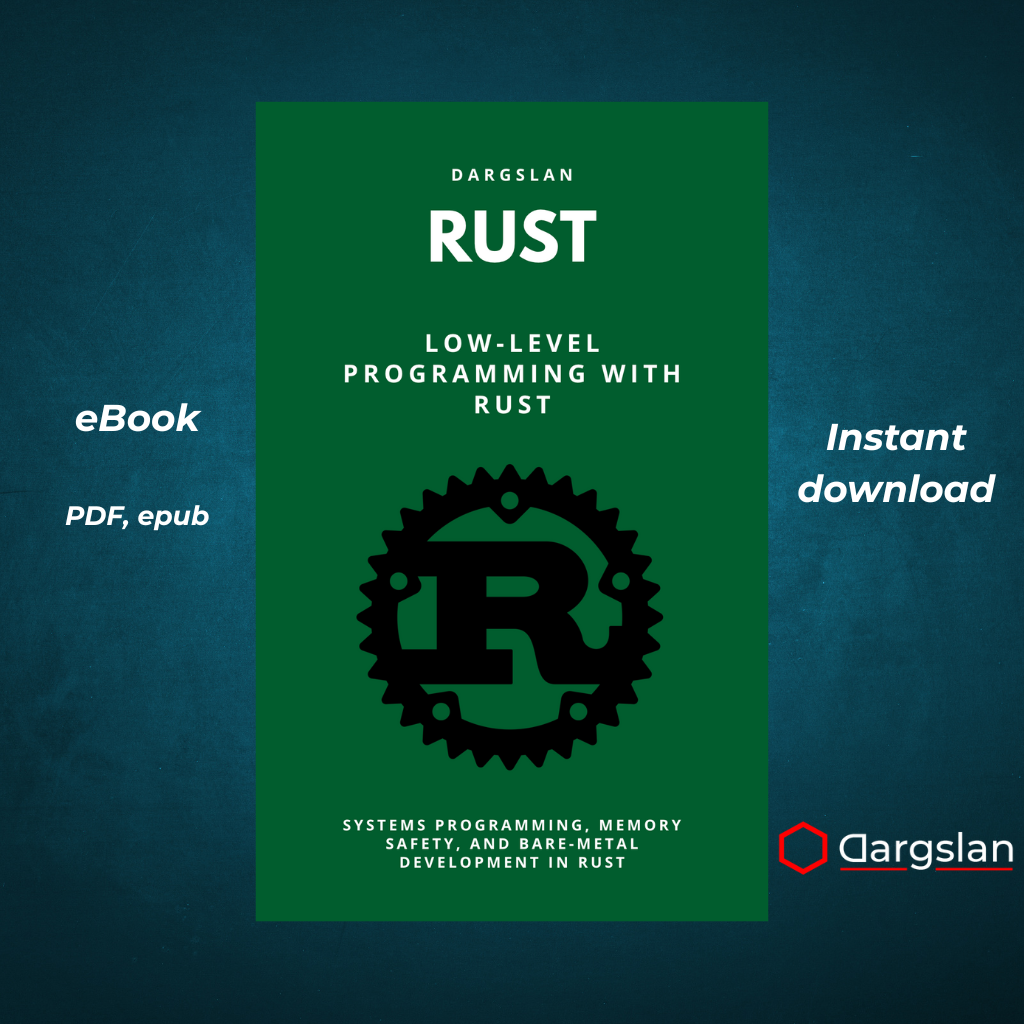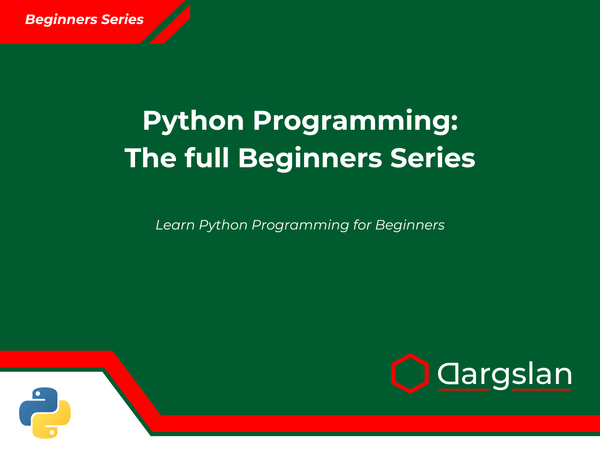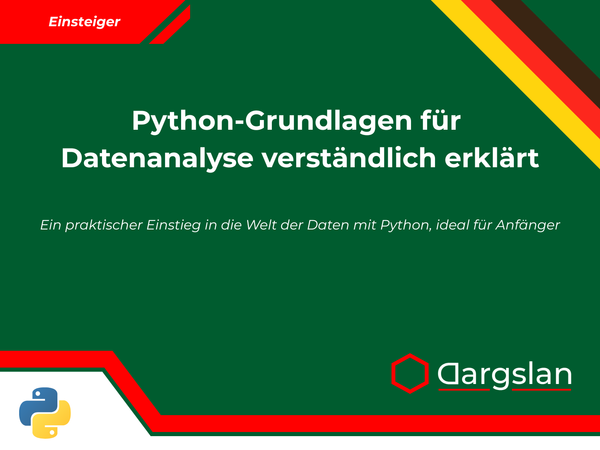Book Review: Low-Level Programming with Rust


Low-Level Programming with Rust
Systems Programming, Memory Safety, and Bare-Metal Development in Rust
Low-Level Programming with Rust: A Comprehensive Guide to Systems Programming and Bare-Metal Development
Book Review and Detailed Overview
Discover how Rust is revolutionizing systems programming by combining performance with memory safety in this definitive guide to low-level development.
In the evolving landscape of programming languages, Rust stands out as a beacon of innovation—particularly in the realm of low-level systems programming. The book "Low-Level Programming with Rust: Systems Programming, Memory Safety, and Bare-Metal Development in Rust" by Dargslan offers a masterful exploration of how Rust's modern features can be applied to traditionally challenging domains of software development.
This comprehensive guide bridges the gap between Rust's safety guarantees and the raw power needed for systems programming. At its core, the book addresses a fundamental question: Can we write performance-critical, hardware-interfacing code without sacrificing memory safety and developer productivity? The answer, as Dargslan expertly demonstrates, is a resounding yes—thanks to Rust's revolutionary approach.
Why This Book Matters in 2025
The tech industry is witnessing a significant shift toward Rust for systems programming. Major players like Microsoft, Google, and Amazon are increasingly adopting Rust for infrastructure projects, operating systems components, and security-critical applications. This transition is driven by a crucial realization: memory vulnerabilities in C and C++ codebases continue to be the root cause of approximately 70% of severe security vulnerabilities.
"Low-Level Programming with Rust" arrives at this pivotal moment, offering both experienced systems programmers and Rust enthusiasts a roadmap to harness Rust's safety features without sacrificing the control and performance necessary for low-level development. As embedded systems proliferate through IoT devices and as cloud infrastructure security becomes increasingly critical, the skills presented in this book are more valuable than ever.
Who Should Read This Book
This book is ideally suited for:
- Systems programmers with C/C++ experience looking to leverage Rust's safety guarantees
- Rust developers wanting to dive deeper into low-level programming concepts
- Embedded systems engineers exploring memory-safe alternatives for firmware development
- Computer science students interested in understanding the intersection of modern language design and systems programming
- Security professionals concerned with memory safety in performance-critical code
While the book assumes some familiarity with Rust basics, it reviews key language features in the context of low-level programming, making it accessible to determined readers with varied backgrounds.
Chapter-by-Chapter Breakdown
Chapter 1: Introduction to Low-Level Programming
The journey begins with a thoughtful exploration of what constitutes "low-level" programming in the modern era. Dargslan establishes a clear framework for understanding the spectrum from high-level abstractions to bare-metal programming, contextualizing Rust's position in this landscape.
The chapter addresses common misconceptions about low-level development and sets realistic expectations about the trade-offs involved. Particularly valuable is the discussion of how Rust's zero-cost abstractions enable a new paradigm where safety doesn't require sacrificing performance or control.
Readers will appreciate the historical perspective on systems programming languages and how Rust represents an evolutionary step forward in this tradition. The author's passion for the subject shines through in engaging examples that demonstrate why mastering low-level programming remains relevant in an age of high-level frameworks and cloud abstractions.
Chapter 2: Rust Language Essentials (Refresher)
Rather than a basic syntax tutorial, this chapter presents Rust's distinctive features through the lens of systems programming requirements. The ownership model, borrowing rules, and lifetime system are explained with particular emphasis on their implications for memory management without garbage collection.
The refresher cleverly focuses on aspects of Rust that directly impact low-level programming:
- How the
unsafekeyword creates a clearly defined boundary between checked and unchecked operations - The importance of traits like
Copy,Clone, andDropfor controlling resource management - When and how to use smart pointers versus raw pointers
- The role of the type system in preventing common low-level programming errors
Code examples progressively demonstrate how Rust's safety mechanisms address historical pain points in systems programming while maintaining performance parity with traditional approaches.
Chapter 3: Understanding the Memory Model
This standout chapter provides an exceptionally clear explanation of computer memory organization and how Rust's abstractions map to physical memory. Dargslan expertly navigates complex topics including:
- Stack versus heap allocation patterns and performance implications
- Memory alignment requirements and how Rust handles them
- Virtual memory concepts and their relationship to Rust programs
- The stack unwinding process during panic conditions
The author's explanation of how Rust's ownership model translates to actual memory operations is illuminating, especially when comparing equivalent C code to demonstrate the runtime behavior. Diagrams throughout the chapter help visualize complex memory layouts and transformations.
A particularly valuable section covers memory-mapped I/O and how Rust's safety guarantees can be maintained even when directly accessing hardware registers—a common necessity in embedded systems programming.
Chapter 4: Working with Pointers and Raw Memory
Chapter 4 delves into the territory where Rust's safety guarantees meet the necessary flexibility of systems programming. The treatment of raw pointers is thorough, with clear guidelines on:
- When and why to use
*const Tand*mut Tversus references - Safe patterns for working with raw pointers within
unsafeblocks - Techniques for pointer arithmetic that minimize the risk of undefined behavior
- Converting between different pointer types and addressing casting concerns
The author doesn't shy away from advanced topics, including custom allocators, manual memory management techniques, and interacting with memory-mapped peripherals. Each concept is reinforced with practical code examples that demonstrate both the capability and the responsibility that comes with bypassing Rust's safety checks.
The chapter concludes with a thoughtful discussion on memory safety vulnerabilities and how Rust's design significantly reduces their likelihood even when using unsafe code—a balanced perspective that neither overstates Rust's guarantees nor understates its advantages.
Chapter 5: Interfacing with C Code (FFI)
Interoperability with existing C codebases is crucial for systems programming, and this chapter provides a comprehensive guide to Rust's Foreign Function Interface (FFI). Dargslan covers:
- Creating and using bindings to C libraries with
extern "C" - Handling C data structures and ensuring proper memory layout
- Managing string conversions between Rust's UTF-8 and C's null-terminated strings
- Error handling across language boundaries
The practical examples include creating bindings for common system libraries and wrapping unsafe C APIs in safe Rust interfaces—a pattern essential for gradually migrating existing systems to Rust. The chapter's approach to building robust abstractions over C code provides valuable design patterns applicable to real-world projects.
Particularly useful is the section on building shared libraries in Rust for use in C programs, completing the bidirectional interoperability picture. The detailed coverage of cbindgen and bindgen tools gives readers practical workflows they can immediately apply to their projects.
Chapter 6: Bit-Level Manipulation and Data Packing
Systems programmers frequently need to manipulate individual bits for tasks ranging from hardware register control to network protocol implementation. This chapter demonstrates Rust's capabilities for bit-level operations with remarkable clarity.
The content progresses from basic bitwise operators to complex bit manipulation techniques:
- Bit flags and bitmasks for configuration and state management
- Efficient bit-packing strategies for memory-constrained environments
- Endianness concerns when working with binary data formats
- Creating type-safe abstractions over bit fields and registers
The author introduces the powerful bitvec crate along with standard library features, showing how Rust enables both safety and expressiveness in an area traditionally prone to subtle bugs.
Real-world examples include implementing a network protocol parser and working with hardware control registers in embedded systems—both showcasing Rust's ability to combine type safety with bit-precise control.
Chapter 7: Systems-Level File and Device I/O
This chapter bridges theory and practice by exploring how Rust programs interact with operating system resources. Instead of simply listing API functions, Dargslan explains the underlying concepts behind file operations, device access, and I/O models.
Key topics include:
- Cross-platform file system operations beyond the standard library
- Memory-mapped file access for performance-critical applications
- Direct device interaction through special files on Unix-like systems
- Asynchronous I/O patterns for high-throughput applications
The examples demonstrate how to build robust abstractions that handle platform differences while maintaining safety and performance. Particularly valuable is the section on non-blocking I/O and its implementation across different operating systems.
The chapter concludes with a project implementing a high-performance log file analyzer that processes gigabytes of data efficiently using the techniques presented—giving readers a template they can adapt for their own I/O-intensive applications.
Chapter 8: Writing a Minimal Operating System in Rust
Perhaps the most ambitious chapter, this section guides readers through creating a basic operating system kernel in Rust. The step-by-step approach makes a typically intimidating subject approachable, covering:
- Bootloader interaction and system initialization
- Memory management and virtual memory setup
- Process scheduling fundamentals
- Basic device driver implementation
Rather than merely presenting code, the author explains the operating system concepts alongside their Rust implementations, making this chapter valuable both as a Rust tutorial and as an introduction to OS development.
The project builds upon the bootloader and x86_64 crates, showing how the Rust ecosystem already provides solid foundations for OS development. By the chapter's end, readers have a functioning (albeit minimal) OS capable of running multiple tasks and handling basic I/O—an impressive achievement that demonstrates Rust's suitability for even the most demanding low-level applications.
Chapter 9: Concurrency and Parallelism at Low Level
While Rust is known for its "fearless concurrency," this chapter goes beyond the standard library abstractions to explain concurrency at the systems level. Dargslan expertly navigates the complex landscape of:
- Atomic operations and memory ordering models
- Lock-free data structure implementation
- Thread synchronization primitives at the hardware level
- Parallelism patterns optimized for modern CPU architectures
The treatment of memory ordering semantics (Acquire, Release, SeqCst) is particularly thorough, with examples demonstrating how subtle changes in memory ordering can affect both correctness and performance.
The chapter's approach to building safe abstractions over low-level concurrency primitives provides valuable design patterns for library authors. For application developers, the performance analysis of different concurrency approaches offers practical guidance for choosing appropriate techniques based on workload characteristics.
Chapter 10: Inline Assembly and CPU Instructions
For scenarios requiring direct control over CPU execution, this chapter demonstrates how to integrate assembly language with Rust code. The author provides a clear introduction to:
- Rust's inline assembly syntax and constraints system
- SIMD (Single Instruction, Multiple Data) optimizations
- CPU-specific instructions for cryptography and performance optimization
- Safe abstractions over assembly routines
The examples progress from simple architectural queries (like reading CPU flags) to complex SIMD implementations that significantly outperform scalar code. Throughout, Dargslan emphasizes creating safe abstractions that encapsulate the necessary unsafe code, allowing it to be used safely by higher-level code.
The cross-platform considerations and architecture-specific optimizations provide valuable patterns for developers working on performance-critical libraries. By the chapter's end, readers understand not just how to write inline assembly in Rust, but when it's appropriate to do so and how to maintain safety and portability.
Chapter 11: Writing Drivers and Working with Hardware
Building on previous chapters, this section tackles the challenging domain of hardware driver development. The comprehensive coverage includes:
- Accessing hardware registers and memory-mapped I/O
- Interrupt handling and real-time constraints
- DMA (Direct Memory Access) operations
- USB, PCI, and other bus protocol implementations
Rather than focusing on specific hardware, the author presents patterns and techniques applicable across different devices. The emphasis on type-safe abstractions for hardware access demonstrates how Rust's type system can prevent many common driver bugs at compile time.
Case studies include developing drivers for both embedded microcontrollers and PC peripheral devices, showing how the same Rust principles apply across the hardware spectrum. The chapter's treatment of concurrency concerns in driver development is particularly valuable, addressing race conditions and interrupt safety in a systematic way.
Chapter 12: Performance Optimization and Profiling
This practical chapter equips readers with methodologies and tools for optimizing low-level Rust code. Instead of focusing solely on micro-optimizations, Dargslan presents a holistic approach to performance:
- Profiling techniques and tools specific to Rust development
- Memory access patterns and cache optimization
- Compiler optimization levels and their implications
- Benchmarking methodologies for reliable performance measurement
The systematic approach to identifying and addressing performance bottlenecks provides a valuable framework applicable to any performance-critical project. Case studies demonstrate optimization of real-world code, with before-and-after benchmarks showing substantial improvements.
Particularly useful is the discussion of performance trade-offs and how to balance multiple concerns like memory usage, latency, and throughput based on application requirements. The author's emphasis on measuring before optimizing helps readers avoid the common pitfall of premature optimization.
Chapter 13: Final Project
The book culminates in an ambitious project that integrates concepts from previous chapters into a complete application. This capstone project involves building a memory-efficient database engine that demonstrates:
- Custom memory management for optimal resource usage
- Lock-free data structures for concurrent access
- Memory-mapped I/O for performance
- Platform-specific optimizations using conditional compilation
The step-by-step implementation serves both as a practical review and as a template for readers' own projects. By working through the design decisions and implementation challenges, readers gain confidence in applying low-level techniques to real-world problems.
What sets this final project apart is its attention to production-quality concerns beyond mere functionality—including error handling, testing strategies, and performance under varying workloads. The result is not just a learning exercise but a genuinely useful reference implementation.
Appendices: Extending Your Knowledge
The book includes three valuable appendices that round out the main content:
Appendix A: no_std Crates and Ecosystem
This comprehensive reference catalogs the growing ecosystem of Rust crates that work without the standard library—essential for embedded development and operating system work. Beyond a simple list, the appendix provides guidance on evaluating crates for stability, maintenance status, and safety.
Appendix B: Useful Tools for Low-Level Rust
The tools appendix covers both Rust-specific utilities and general systems programming tools, with practical examples showing how they integrate into the development workflow. Coverage includes debuggers, memory analyzers, profilers, and hardware simulation tools.
Appendix C: Further Learning and Resources
The final appendix provides a curated pathway for continued learning, organized by topic area. This thoughtfully assembled collection of books, papers, online resources, and community forums helps readers deepen their knowledge in specific areas of interest.
Strengths and Unique Contributions
"Low-Level Programming with Rust" stands out in several important ways:
Balanced Technical Depth
The book strikes an excellent balance between accessibility and technical depth. Concepts are introduced clearly enough for intermediate Rust programmers to follow, yet the coverage extends to advanced topics that even experienced systems programmers will find valuable.
Practical Safety Focus
Throughout the book, Dargslan demonstrates how to write low-level code that is both safe and performant. Rather than treating safety and performance as opposing concerns, the examples consistently show how Rust's design enables both simultaneously.
Real-World Applicability
The examples and projects feel drawn from practical experience rather than contrived for teaching purposes. This approach ensures that readers learn patterns and techniques they can immediately apply to their own work.
Ecosystem Awareness
The book doesn't attempt to reinvent the wheel but instead shows how to leverage Rust's growing ecosystem of libraries and tools. This practical approach helps readers become productive quickly while understanding the foundations well enough to dive deeper when necessary.
Comparison with Other Books
Compared to other books in the systems programming space, "Low-Level Programming with Rust" occupies a unique position:
- Unlike general Rust books that briefly touch on unsafe code, this work provides comprehensive coverage of systems programming concerns
- Compared to traditional C/C++ systems programming books, it demonstrates how Rust's safety features address historical pain points
- Unlike academic texts on operating systems or embedded development, it maintains a practical focus on working code and real-world considerations
Most notably, while there are excellent books on Rust and separate excellent books on systems programming, this may be the first comprehensive treatment of systems programming specifically through Rust's perspective.
Conclusion: A Landmark Resource for Modern Systems Programming
"Low-Level Programming with Rust" arrives at a crucial moment in computing history. As systems programming evolves to meet the security and reliability demands of modern infrastructure, Rust offers a compelling path forward that doesn't sacrifice the performance and control that systems programmers require.
Dargslan's book serves as both a practical manual and a conceptual guide to this new territory. It demonstrates how Rust's innovations address longstanding challenges in systems programming while opening new possibilities for safe, concurrent, and efficient code.
For professional developers, the book provides immediately applicable techniques for writing better systems code. For students and educators, it offers a modern perspective on traditional systems programming concepts. For the Rust community, it represents a significant contribution that will help the language continue its growth in critical infrastructure domains.
Whether you're writing an embedded application, developing driver code, optimizing a performance-critical library, or simply seeking to understand computers at a deeper level, "Low-Level Programming with Rust" deserves a place on your shelf. In years to come, it may well be regarded as one of the definitive works that helped transition systems programming into a new era of safety without compromise.
This review covers "Low-Level Programming with Rust: Systems Programming, Memory Safety, and Bare-Metal Development in Rust" by Dargslan, based on the preface and table of contents. The book presents a comprehensive guide to low-level programming using Rust's unique features to achieve both performance and safety in systems development.

Low-Level Programming with Rust






